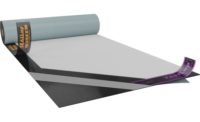Next-Generation Plastics for High-Performance Roofing Membranes

Photo courtesy of Sika Corporation.
As the built environment reaches new heights of innovation, roofing systems must evolve to meet new challenges. Roofing membranes, the unsung heroes safeguarding structures from the elements, have transformed to become the first line of defense against water leaks, moisture and chemical damage. Thanks to breakthroughs in materials science, today's roofing membranes are designed for remarkable durability and performance.
Fundamentals of Roofing Membranes
At its core, a roofing membrane serves as a crucial barrier against leaks, ponding water and energy loss – ultimately enhancing building operations. That means less safety hazards due to standing water from leaks, reduced infestations from moisture and lower energy costs.
However, commercial and industrial buildings often encounter distinct environmental hazards that demand more than just basic protection. As a result, chemical-resistance, fire-resistance, durability and longevity are vital for the overall protection that roofing materials offer. In recent decades, innovations in roofing membrane technology have advanced significantly to address these stringent requirements.
Single-Ply Possibilities of Polymeric Materials
As the roofing industry evolves, durability, cost-efficiency and weatherability have become paramount in the development of single-ply roofing membranes. Materials like EPDM (ethylene propylene diene terpolymer) and PVC (polyvinyl chloride) offer roofing manufacturers the flexibility to create custom formulations tailored to specific designs, production processes and end-use requirements.
EPDM, for instance, can be formulated with varying molecular architectures that offer longevity, weather resistance, flexibility and low temperature toughness. Recent advancements in EPDM product design have also led to improved mechanical performance, increased filler loading (the addition of inexpensive mineral fillers to offset the system costs of EPDM membranes) and better processability.
While high filler loading in compound formulations can lead to inefficient mixing and poor dispersion of additives, potentially impacting the physical properties of the end-use product, the EPDM product designs have addressed these challenges with more homogenous filler incorporation and dispersion. With a unique molecular structure design, next-generation EPDM products can offer higher tensile strength for the membrane and maintain increased performance levels even as more filler is added in the compound formulation.
When More is Needed in a Membrane
Another development in roofing technology is the use of ketone ethylene ester (KEE) as a polymeric plasticizer in PVC roofing membranes. This innovation marks a significant advancement in chemical resistance, weatherability and overall resiliency.
PVC-based systems require a plasticizer to maintain long-term flexibility and durability. Traditionally, liquid plasticizers have been used, but they tend to migrate out of the roofing membrane over time, which can lead to membrane drying and cracking. KEE, however, is a solid and non-migrating polymeric PVC plasticizer, which means the roofing material is less likely to crack due to plasticizer loss over time.
PVC roofing membranes with KEE offer excellent resistance to fire, water intrusion and chemical degradation which can help safeguard valuable equipment, making it suitable for critical infrastructure such as data centers and airports. Its durability translates to longer lifespans and reduced maintenance costs, making KEE a compelling choice for long-term performance.
As societal needs evolve, so does roofing technology. Continuous advancements in materials science are extending the lifespans and durability of roofs, which is increasingly important as severe weather events become more frequent and the pressure to limit waste grows. The longer a roof remains intact and functional, the fewer repairs and replacements are needed, which can be economically and environmentally beneficial. With less need to for replacements, there is a reduction in material usage, total ownership costs and industrial waste. The future of roofing is bright, driven by innovation and a relentless pursuit of durability.
Looking for a reprint of this article?
From high-res PDFs to custom plaques, order your copy today!





